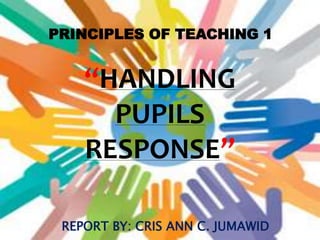Handling Pupils Response
•Download as PPTX, PDF•
3 likes•2,379 views
As a teacher, it is important to be able to handle the students' responses correctly because the way you handle the responses of students can affect the way the students receive corrections. Accepting mistakes and correction is crucial when it comes to the students so it is advised that the teachers be able to handle them properly.
Report
Share
Report
Share

Recommended
Vision, Policy, Goal and Objectives of Special Education in the Philippines

Vision, Policy, Goal and Objectives of Special Education in the Philippinesmaria martha manette madrid
Recommended
Vision, Policy, Goal and Objectives of Special Education in the Philippines

Vision, Policy, Goal and Objectives of Special Education in the Philippinesmaria martha manette madrid
More Related Content
What's hot
What's hot (20)
GUIDELINES CONSTRUCTING MULTIPLE CHOICE TEST ITEMS.pdf

GUIDELINES CONSTRUCTING MULTIPLE CHOICE TEST ITEMS.pdf
Professional education reviewer for let or blept examinees

Professional education reviewer for let or blept examinees
OUTCOMES-BASED EDUCATION (OBE) OR OUTCOMES-BASED TEACHING AND LEARNING (OBTL)

OUTCOMES-BASED EDUCATION (OBE) OR OUTCOMES-BASED TEACHING AND LEARNING (OBTL)
Similar to Handling Pupils Response
Similar to Handling Pupils Response (20)
The art of questioning an essential skill for successful teaching.

The art of questioning an essential skill for successful teaching.
Strategies to Address Needs of Struggling Students

Strategies to Address Needs of Struggling Students
Recently uploaded
https://app.box.com/s/7hlvjxjalkrik7fb082xx3jk7xd7liz3TỔNG ÔN TẬP THI VÀO LỚP 10 MÔN TIẾNG ANH NĂM HỌC 2023 - 2024 CÓ ĐÁP ÁN (NGỮ Â...

TỔNG ÔN TẬP THI VÀO LỚP 10 MÔN TIẾNG ANH NĂM HỌC 2023 - 2024 CÓ ĐÁP ÁN (NGỮ Â...Nguyen Thanh Tu Collection
Recently uploaded (20)
Unit 3 Emotional Intelligence and Spiritual Intelligence.pdf

Unit 3 Emotional Intelligence and Spiritual Intelligence.pdf
ICT role in 21st century education and it's challenges.

ICT role in 21st century education and it's challenges.
UGC NET Paper 1 Mathematical Reasoning & Aptitude.pdf

UGC NET Paper 1 Mathematical Reasoning & Aptitude.pdf
Sensory_Experience_and_Emotional_Resonance_in_Gabriel_Okaras_The_Piano_and_Th...

Sensory_Experience_and_Emotional_Resonance_in_Gabriel_Okaras_The_Piano_and_Th...
Python Notes for mca i year students osmania university.docx

Python Notes for mca i year students osmania university.docx
Food safety_Challenges food safety laboratories_.pdf

Food safety_Challenges food safety laboratories_.pdf
HMCS Max Bernays Pre-Deployment Brief (May 2024).pptx

HMCS Max Bernays Pre-Deployment Brief (May 2024).pptx
Kodo Millet PPT made by Ghanshyam bairwa college of Agriculture kumher bhara...

Kodo Millet PPT made by Ghanshyam bairwa college of Agriculture kumher bhara...
ICT Role in 21st Century Education & its Challenges.pptx

ICT Role in 21st Century Education & its Challenges.pptx
General Principles of Intellectual Property: Concepts of Intellectual Proper...

General Principles of Intellectual Property: Concepts of Intellectual Proper...
TỔNG ÔN TẬP THI VÀO LỚP 10 MÔN TIẾNG ANH NĂM HỌC 2023 - 2024 CÓ ĐÁP ÁN (NGỮ Â...

TỔNG ÔN TẬP THI VÀO LỚP 10 MÔN TIẾNG ANH NĂM HỌC 2023 - 2024 CÓ ĐÁP ÁN (NGỮ Â...
Unit-V; Pricing (Pharma Marketing Management).pptx

Unit-V; Pricing (Pharma Marketing Management).pptx
Handling Pupils Response
- 1. PRINCIPLES OF TEACHING 1 “HANDLING PUPILS RESPONSE” REPORT BY: CRIS ANN C. JUMAWID
- 3. In providing corrective feedback: * Remember that the reaction “That’s wrong” can put off or embarrass a learner. Be more tactful. * Give a hint or break down the question if necessary, to guide the learner to the correct response.
- 4. * Explain the correct answer when the learners cannot arrive it all. * Initially ask easy questions to enhance the student’s (particularly a slow one’s) self-confidence and to encourage active participation from everyone.
- 5. ◦ 2. GIVING APPROPRIATE PRAISE TO HIGH QUALITY RESPONSES.
- 6. In giving appropriate praise: * Match praise to the level of difficulty of the question answered or to the quality of the response given. * Very acceptance reactions. As someone said, there are 99 ways of saying “okay”.
- 7. ◦ * Remember that a slow/insecure learner needs more praise than a fast/confident one. Be discreet, lest the faster ones think that praise is only for the slow learners.
- 8. ◦ 3. MAKING FOLLOW UP QUESTIONS
- 9. In making follow up questions: * Remember that follow up questions should logically relate to the preceding questions and/or the learners response.
- 10. * Follow-up questions should be characteristically developmental and directed towards a better/deeper understanding of the topic being discussed. * Clearly-stated, short follow-up questions elicit better responses from the students.
- 11. Redirecting Questions ◦ * Certain questions observe to be answered by more than one learner. Take advantage of this opportunity to promote creative or divergent thinking.
- 12. * Some students need a re- formulation of the question for better understanding. Be sensitive and accommodating to such need.
- 13. 5. FOLLOWING-UP A STUDENT’S RESPONSE WITH RELATED QUESTIONS.
- 14. In explaining the question/answer: * Slowly repeating or replacing certain words in a question may be the way to enable a student to give the correct answer.
- 15. 6. REPHRASING THE SEEMINGLY UNCLEAR QUESTION ◦ * Rephrase unclear questions by using terms or idioms familiar to the student. * Avoid long and complicated sentence structures in asking questions.
- 16. 7. SHOWING NON-VERBAL ENCOURAGEMENT. In showing nonverbal encouragement: * Body language, particularly a teacher’s facial expression during recitation communicates a message of encouragement or otherwise to students. * Eye-to-eye contact, a smiling face, and an encouraging hand gesture remove fear of embarrassment from the students.
- 17. 8. ENCOURAGING LEARNERS TO ASK QUESTIONS ◦ * Watch out for students who seem to have problems(via nonverbal indicators) about certain responses. Encourage them to bring out their questions. (Source: SEAMEO INNOTECH. The Interactive Instruction Series for Teacher Education, Trainor’s Manual on The Art of Questioning and Reacting Techniques,1994)